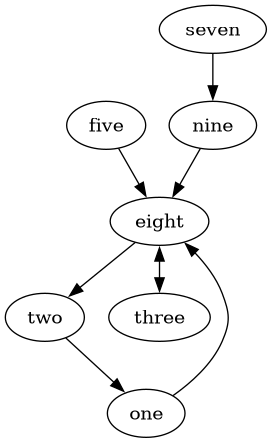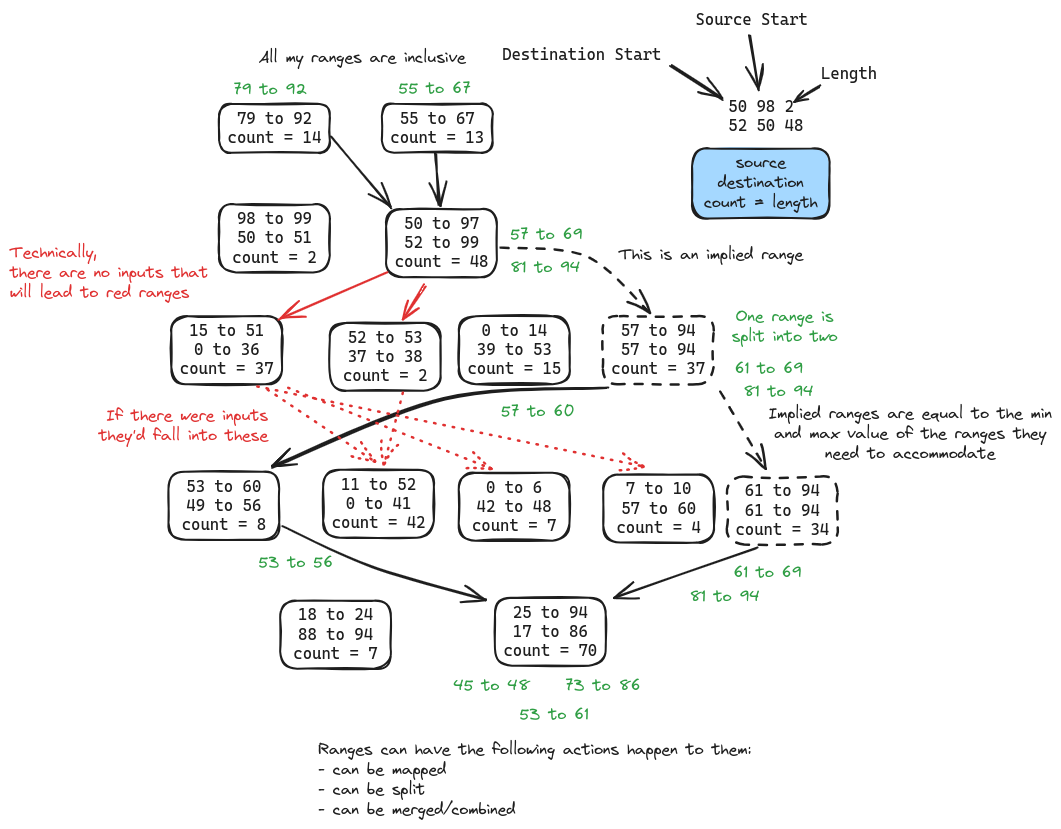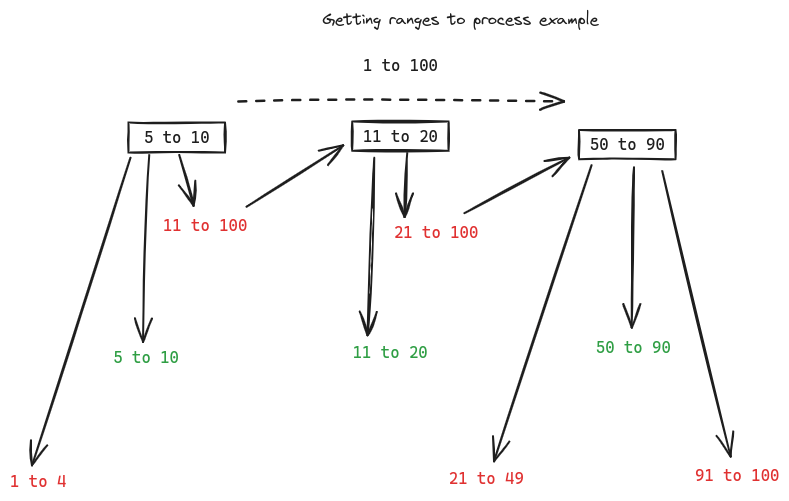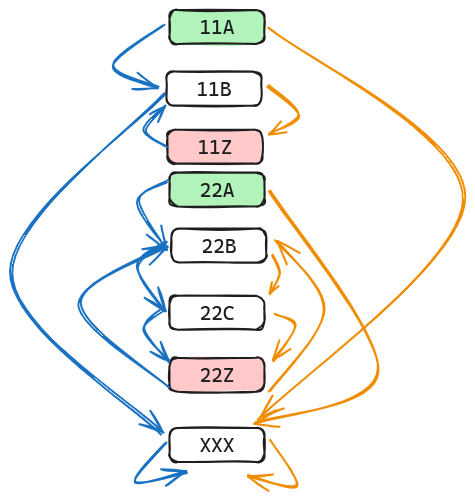AdventOfRust 2023
13 Dec 2023So it’s two weeks into 2023’s Advent of Code and I have a confession to make. I’ve been using it to learn Rust.
In my last post I mentioned I’d try to use Advent of Code to learn Zig only to flounder at the first hurdle. So I settled on improving my Python skills.
Well, in those two weeks I decided to still try my hand at a new programming language, and settled on looking at Rust. A language I had initially looked at some time between 2016 and 2018 but not really paid much attention to since then. I knew it was touted as a “safe” replacement for C/C++, and that it had a novel system for managing memory that was both manual (so no garbage collection like Scala) but also automatic (through some clever systems related to ownership of variable).
Part of what attracted me to Rust was what had turned me off of Zig, the state of its documentation and tooling; Cargo is a fantastic package manager and build tool, with an ergonomic CLI interface and configuration file (it uses TOML, which I have mentioned before on this blog), there is an LSP that works flawlessly with Cargo and NeoVim called rust-analyzer, and there’s more documentation online than you can shake a stick at.
With all that said, how am I finding Advent of Code 2023 so far? And how am I finding doing it in Python and Rust?
As of time of writing I have done 9 out of the available 13 days, and will break down each one in brief.
Day 1
Day 1 was an easy enough challenge, and
became a little harder in part 2 thanks to a gotcha related to the fact that
numbers as words can overlap. For instance eightwothree represents the
sequence [8, 2, 3].
I spent a little time confused with my Python solution, due to a typo, and went slightly mad thinking there was a scoping issue with a variable (curse of weakly typed languages). Eventually, I used a Regular Expression to do the parsing.
For part 2 I made a silly mistake and forgot to allow the last character of each substring I was searching for from being the beginning of another word (the gotcha I mentioned).
I mentioned on Twitter and Mastodon that aspects of this question could make up a good interview question. I even produced a fun little graph of how the word based numbers can flow into each other:

Eventually, this was the first question I repeated in Rust on the evening of December 4th.
Day 2
Day 2 was a lot easier than day 1 for me. I found no real gotchas in it.
Again, like day 1, I used Regular Expressions to do the parsing, although it is easy enough to do it without them. Which is exactly what I did when I repeated this question in Rust.
Day 3
Day 3 was a little harder than day 2. It involved building what was essentially a 2D map of the input file.
I struggled a little, but when I was solving it I was not at my usual desk and had a lot of distractions in the environment. I put off the part 2 to the next morning and thought of a much nicer way of storing the data. At some point I’d like to redo part 1 but I am in no rush.
Day 4
Day 4 part 1 was very straightforward, just an act of parsing the input data, then generating a score based on it. With the score happening to be 2 to the power of the number of matching numbers minus 1.
Part 2 was a little more involved but not complex. It suits recursion perfectly but, in Python especially, I was worried about stack overflows with the input data so reached for a stack/queue based solution.
Day 5
Day 5 part 1 was pretty easy to solve, you have input seeds and a whole load of ranges to map them through to get the results.
The example given was small, and easy to process since it only had 4 values and very small maps. So initially, I went for a naive approach where I generated all the possible values in each range and what they mapped to. Which worked great on the example input data. However, as soon as I plugged in the real input data I was maxing out my memory!
So to solve this memory issue with my naive approach I redid the map ranges to just store the ranges and had a class that simply mapped the input across these without instantiating millions of values. That solved part 1.
Unfortunately, it didn’t solve part 2, even though it would essentially be
O(n) in Big O notation. That’s because part 2 reveals that there are many
millions of seed values. So, even with a linear algorithm, processing that many
items would take a very long time! For me these ranges added up to a total of
1,844,955,419 seeds, which would take 21 days working at 1 seed per
millisecond!
I considered parallelising the existing code, but that would only cut the processing time down to a few days. Still not good enough!
Re-reading the question:
What is the lowest location number that corresponds to any of the initial seed numbers?
And looking at the input gave me an epiphany. Everything is a range. So I don’t need to map each individual seed value. I just need to map all the ranges!
I came up with the following:
- We have an initial set of
nranges - At each stage, each range has a function applied to it that alters it’s start and end values or splits it into multiple ranges
- We repeat step 2 until we have no more stages
- We take our set of ranges and just take the minimum from them
This reduces the average amount of overall calculations to approximately n,
ignoring the constants. In a worst case, we could have ranges of size 1 for
many input seeds, and every stage would need that many map steps. But
thankfully, all these ranges are linear, so that can’t actually happen if we
add an optimization to merge contiguous ranges together.
So revising the above pseudo-steps into working on the whole set of ranges at each stage, I came up with the following:
- We have an initial set of
nranges - We merge any contiguous ranges in our set into single ranges
- For the current stage, apply the mappings to the ranges, including any implied mappings. This can split the sets up.
- Repeat step 3 and 4 until there are no more stages
I ended up implementing this in Rust more easily than Python, and it worked in far less than 21 days!
Because this was quite hard to visualise without diagrams I turned to Excalidraw and created the following:

The above is a part way worked example of how ranges travel through the given example data.
And below is a simplified version of a seed range going through each of the mapping ranges:

It’s important that the ranges are ordered sequentially for mapping so when split you can safely ignore the left range.
Day 6
I didn’t take many notes on Day 6, probably because it frustrated me.
I only solved it in Python. Part 1 was easy, but part 2 required use of the Quadratic Formula, which I recognised straight away, but I haven’t used in at least a decade. Ultimately, after a lot of searching, reading and tinkering, I got it working.
Day 7
Again, I took little notes for Day 7 and only solved it in Python.
I used enumerated types in Python, and the Counter data type. Parsing the
data wasn’t too hard, and nor was telling which hand was which. Most of the
problems I had stemmed from forgetting to add the five of a kind hand to the
initial set of a possible hands, and then doing something similar in Part 2
when upgrading the hands with the wild cards.
Day 8
Day 8 was fun. I completed it all in Rust with no Python implementation, which is probably how I will continue with the other questions going forward.
Part 1 was straightforward, but, much like day 5, it became more complicated in part 2.
My intuition was to parse the data into a nice node data structure, with each node having an id, a left and right field for the next node and a node type. I didn’t actually create a full graph, but instead used a Hash Map to store all the nodes in based on their ids.
#[derive(Debug, Hash, PartialEq, Eq)]
enum NodeType {
Start,
End,
Normal,
}
#[derive(Debug, PartialEq, Eq, Hash)]
struct Node {
id: String,
left: String,
right: String,
node_type: NodeType,
}
Part 1 was a case of iterating along the instructions until encountering the
exit node ZZZ. With the structures I used this was simple.
Part 2, at first glance, looks as simple as Part 1. It is, but it factors out very fast. In the data I had, there were 6 starting nodes, so 6 nodes to check every loop. However, they don’t sync up on end nodes for billions of iterations.

I initially wrote some code that got up to 720 million iterations. This took a long time, and wasn’t even the final answer. So, looking at the data structure I realised a few things:
- This is a closed, balanced graph, so all nodes always reach another one
- The question guarantees that all start nodes eventually will connect to end nodes
- Given the volume of data, there must be closed loops, and because all nodes eventually connect to end nodes, these loops must have valid end nodes within them
So instead of iterating and checking every iteration if all 6 nodes are end nodes, I can simply identify each closed loop for each node. Then I can find the lowest common multiplier between all of their lengths and that is my answer.
This took a little bit of trial and error in Rust to write. I mostly got confused on how to recognise the closed loops/cycles correctly. With that eventually solved, I actually had to halve each iteration count because each represented identifying the loop, which will be twice as a long as the actual loop. Then with some simple greatest common divisor and lowest common multiplier functions I was done.
/// Find greatest common divisor
fn gcd(mut m: usize, mut n: usize) -> usize {
while m != 0 {
let old_m = m;
m = n % m;
n = old_m;
}
return n;
}
/// Find lowest common multiple
fn lcm(a: usize, b: usize) -> usize {
a * b / gcd(a, b)
}
Day 9
Day 9 is the last challenge I have done at time of writing. And as stated in Day 8, I only implemented it in Rust.
Part 1, like a lot of the challenges, was fairly easy. It just involves building progressively smaller lists and then summing their new ending values.
Part 2, was also surprisingly easy, at least it was for me thanks to how I structured my code from part 1. All I needed was a flag in my code to calculate a similar value to part 1 just for the front of each Vec I used.
Day 10+
Day 9 is all I have gotten up to right now, which puts me about 5 days behind. Not too bad, all things considered. Especially, since I stopped at Day 4 the last time I tried Advent of Code.
Overall, I am getting to grips with Rust as I go. I am still a bit fuzzy on the way explicit lifetimes work within it, but I think Day 10 will give me cause to understand that more. I am finding Rust to be quite an enjoyable language to build stuff in, thanks to its excellent documentation and super helpful compiler error messages.
I think the speed at which I am getting to know how to use it can be attributed to my knowledge of C and Scala. The low-level knowledge around memory and pointers from C helps me parse how the borrow checker works, and the functional aspects from Scala help me understand the structure of the Rust standard library, including it’s Result and Option types.
Once Advent of Code 2023 is over I will make my solutions public on GitHub. Until then, happy holidays!


Comments